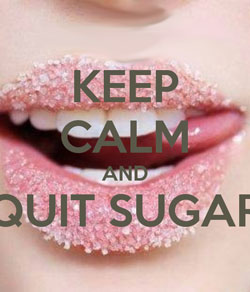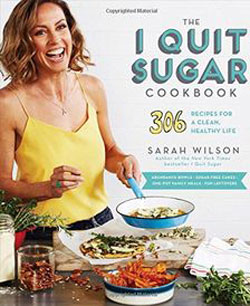Amazing Things Can Happen When You Give up Sugar. Here’s How to Do It
 You might be wondering why giving up added sugar is a good idea, so here’s a brief overview.
You might be wondering why giving up added sugar is a good idea, so here’s a brief overview.
Improvements you might experience with less sugar in your diet:
– Better sleep
– Weight loss
– More energy
– Increased focus
– Improved mood
– Better overall health
Reduced risk of developing health problems including but not limited to:
– Type 2 diabetes
– Metabolic syndrome
– High triglycerides
– Heart disease
– Non-alcoholic fatty liver disease
– Obesity
– Cancer
– Cell aging
– Deficiencies in cognitive health
As you can see, you have a lot to gain and nothing to lose (except perhaps some extra body fat) by reducing or eliminating added sugars from your diet.
 But should you quit sugary food, or gradually phase it out of your life?
But should you quit sugary food, or gradually phase it out of your life?
To figure this out, first ask yourself – and be honest when you answer: can you do moderation?
A lot of people really struggle with it – “just one” cookie ends with the entire box disappearing. Having “just one” soda drink results in two or three cans chugged by mid-afternoon.
If you can do moderation, then work on gradually reducing your consumption of added sugars over time. After a few weeks, you’ll be surprised at how little you miss it.
If you cannot do moderation, cutting added sugars out completely is your best option, but you may experience some withdrawal symptoms and intense cravings for a week or so.
Giving up sweet food might be challenging at first, but rest assured – the cravings will eventually go away. Choosing to gradually reduce your intake can work too, but you might find it more difficult, as each bite of something sweet is likely to trigger a vicious cycle of cravings. Have a cookie or two after dinner and crave a donut the next morning, and so on. It will be difficult to break the cycle if you keep indulging.
Important reminder: we are talking about reducing added sugars. Many foods naturally contain natural sugars, and some of those are fine (examples: berries, apples, carrots).
You don’t need sugar as much as you think you do. In fact, you can train your taste buds to enjoy things that aren’t as sweet.
Try cutting out one sweet food from your diet each week. For example, pass on dessert after dinner or skip that mid-afternoon candy bar. Start putting less sugar in your coffee or cereals. Over time, you will lose your need for that sugar taste.
Eat more fruits and vegetables. You’ll notice their natural sweetness and they’ll taste better, too.
 Drink extra water. Try making flavored waters infused with fruit and herbs if you find it hard to drink plain water.
Drink extra water. Try making flavored waters infused with fruit and herbs if you find it hard to drink plain water.
If you drink soda, juice, or other sugary beverages, reduce your intake or cut them out of your diet completely.
Eat fruit and vegetables. Yes, juice comes from fruit, and yes, fruit contains nutrients, but juice lacks fiber and is much easier to over-consume than whole fruit. If you must have juice, save it for special occasions, dilute it with water, or have a very small serving.
You can overdo it on fruit and starchy vegetables, too, so be mindful. Berries, avocado, cruciferous vegetables (like broccoli, cauliflower, kale, cabbage, and Brussels sprouts), leafy greens, mushrooms, tomatoes, radishes, cucumber, zucchini, green beans, carrots, and bell peppers are among the best low-sugar options.
Try replacing sugary drinks with unsweetened tea.
Get rid of any sugary temptations at home and at work. This includes any ingredients or mixes you may have in your pantry that can be used to make sweet treats like cookies, brownies, or cake.
Consume enough protein, healthy fats, and fiber. They digest more slowly and don’t make your blood sugar spike the way refined carbohydrates and sugars do, and can help you stay full longer.
If you are a fan of nut butters, get the ones that don’t contain added sugar, or make your own without sweetener.
Avoid artificial sweeteners – some studies have shown they can increase cravings for sweets.
Brown sugar and cane juice may sound healthful, but sugar is sugar. Unrefined sugars are a tiny bit higher in nutrients, but they can still cause your blood sugar to rise.
 Read food labels, and choose items that don’t have a lot of sugar or better yet, are unsweetened.
Read food labels, and choose items that don’t have a lot of sugar or better yet, are unsweetened.
Sugar hides where you’d least expect it, including in pasta sauces, salad dressings, flavored yogurt, protein/energy bars and bread. Ingredients are listed in order of how much exists in the product, so if sugar is near the top, that’s a red flag. Watch for labels that say “fat free”, “light”, or “low fat.” Those terms are often code for “high in sugar or artificial sweeteners”.
Speaking of reading labels, you’ll need to know how to recognize sugar by its aliases, and there are many. According to SugarScience.org, there are at least 60 names for sugar (yet some of them are healthy options): Agave nectar, Barbados sugar, barley malt, barley malt syrup, beet sugar, brown sugar, buttered syrup, cane juice, cane juice crystals, cane sugar, caramel, carob syrup, castor sugar, coconut palm sugar, coconut sugar, confectioner’s sugar, corn sweetener, corn syrup, corn syrup solids, date sugar, dehydrated cane juice, Demerara sugar, dextrin, dextrose, evaporated cane juice, free-flowing brown sugars, fructose, fruit juice, fruit juice concentrate, glucose, glucose solids, golden sugar, golden syrup, grape sugar, high-fructose corn syrup (HFCS), icing sugar, invert sugar, malt syrup, maltodextrin, maltol, maltose, mannose, maple syrup, molasses, muscovado, palm sugar, powdered sugar, raw sugar, refiner’s syrup, rice syrup, saccharose, sorghum syrup, sucrose, sugar, sweet sorghum, syrup, treacle, turbinado sugar, yellow sugar.
Whew! That’s a long list, but good information to have.
Some products may contain more than one of those kinds of sugar, by the way.
The best way to avoid added sugars is to prepare your own meals at home using fresh foods. Stick with fruits, vegetables, eggs, natural cheeses (not processed “cheese food”), unsweetened yogurt, nuts, seeds and healthful oils.
When you find yourself craving sugary stuff, remember… you don’t need it. You are sweet enough already!
yogaesoteric
March 1, 2017
